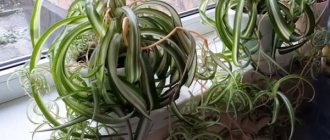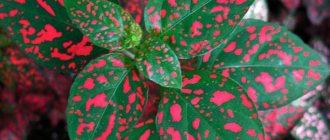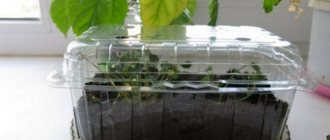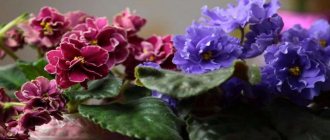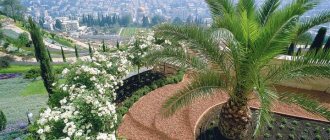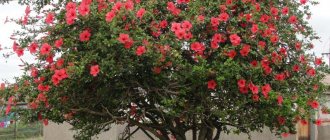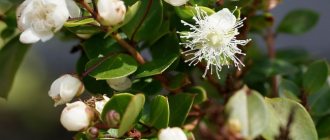Plants in a modern home are an important part of the interior. They create comfort, add zest, and purify the air. But the functions of plants are not limited to this: each has its own energy, which affects the house and those living in it. For example, many signs have been invented about Hamedorea elegans. This unpretentious palm has a good aura. But without proper care, the beneficial properties of the plant may not appear.
What does chamedorea symbolize?
Hamedorea is popularly called bamboo, sometimes mountain palm. Recently, it is increasingly used as an indoor flower, since it easily adapts to any conditions and does not require much attention. From the point of view of signs, it is valued as a symbol of victory and triumph, which makes it a success among owners involved in sports, creative or business activities.
Even the ancient Egyptians symbolized chamedorea with the Sun deity Ra, giving the flower healing and rejuvenating properties. The decorative home palm tree is used for spiritual practices because it “carries” solar energy, and is also a collector of positive waves of mood and atmosphere, accumulating and dispersing them.
However, in order for the signs to be justified and have power, the chamedorea still needs special care, communication with the person who will be magically influenced.
What does the plant look like?
Chamaedorea elegans is a low-growing plant from the Palm family. Naturally distributed in humid mixed and tropical forests in Mexico and Guatemala. Cultivated as an ornamental plant, often found in indoor floriculture.
It has numerous, densely arranged thin stems, reminiscent of reeds or bamboo, up to 2 m in height. Each shoot contains 6-7 pinnate, arcuately inclined leaves on long petioles. During the decorative period, chamedorea bears yellow or orange-red small buds collected in axillary paniculate inflorescences.
The fruits of the crop are spherical berries up to 6 cm in diameter with black skin and an orange stalk. The pulp contains only one seed.
Attention! Hamedorea at home begins to bloom at the age of 3-4 years. At the same time, it can reach only 30 cm in height - small sizes do not impair the decorative effect.
Hamedorea gracilis is also called reed palm or bamboo palm.
The magical properties of the chamedorea plant
According to signs, the main magical property of chamedorea is to accumulate positive energy. It absorbs the sun's rays and is charged with the positive mood of the owners and guests, without harming them. Unlike harmful flowers, which feed on the health and vitality of people, chamedorea only “inhales” all the good things that others exude.
The flower gives back all these reserves of positive energy at the right moment, filling the environment with positive fibers. With chamedorea, the house is fresher and brighter. But this is not all of its functions. It is noted that it is equally suitable for businessmen, artists, and athletes. Moreover, both beginners and proven and famous personalities. For example, Chamedorea elegans, according to signs and superstitions, reveals the creative potential of such people, gives them a clear mind, and gives them willpower to achieve ever greater goals.
Hamedorea reveals the creative potential of its owners
Why does chamedorea bloom?
At home, palm trees rarely bloom. First, they will need to create optimal conditions, including finding the right place according to Feng Shui.
- Hamedorea has two “patrons” - Wood and Metal, so it feels great both in the Western or North-Western, as well as in the South-Eastern Sector.
- There is no place for a plant in the bedroom - it is not recommended to keep it next to you around the clock or during sleep.
- But for diseases of the musculoskeletal system, “treatment” with chamedorrhea is recommended - daily for 1-2 hours.
When the palm is satisfied with everything, the leaves acquire a light green color. The appearance of a Hamedorea flower is called an indicator of its highest contentment. Next to such a tree, you can rest assured that you are completely protected from the vicissitudes of fate.
Signs and superstitions about Hamedorea
To have an idea about the chamedorea flower, you should look at it in the photo, and also find out the signs in the house. If you plant it in a suitable pot and place it under diffused sunlight, the flower will not only purify the air of toxic substances, but instead saturate it with oxygen. According to signs, it is believed that chamedorea actively absorbs negativity, protects against the evil eye, preventing it from reaching its owners. In addition, it improves the home atmosphere, makes the atmosphere peaceful, and the relationships of household members harmonious.
Attention! Hamedorea processes negative energy so effectively, giving the superstitious one positive energy, that not a single so-called energy vampire can stay close to such a person for a long time.
Signs claim that the presence of a flower in the house and sufficient presence of a person nearby will help the latter to establish a career, creative and business endeavors will be more successful, a person will more easily overcome possible difficulties without focusing on them, since chamedorea takes away the negative at the first contact. In order to stay near the flower longer, esotericists note that it can be installed in the bedroom, given that it does not require direct sun.
The meaning of palm trees in feng shui
Hamedorea is given a special place in this Eastern teaching. It is believed that the palm tree can absorb positive energy from the surrounding space. Then she gives it back again, strengthening it many times over. Esotericists advise meditating next to this plant. You can just sit near a palm tree, reflect on your life, plans and dreams. Hamedorea will help you get into the right frame of mind and tell you in which direction to move.
The plant fills a person with new strength. It is able to absorb negativity, thereby eliminating tension between family members. Hamedorea will help improve relationships in a team thanks to its ability to equalize energy flows in a room. It is important that people themselves treat the flower well and do not forget that it requires care.
Followers of Feng Shui believe that a palm tree needs to be correctly installed:
- in the hallway - protection from external negativity;
- in the office there is a good psychological atmosphere in the team;
- in the bedroom - calms, sets the mood for relaxation;
- in the office - helps to focus on the main thing.
Features of flower care
The flower is considered unpretentious - keep away from the scorching sun and water it in a timely manner. Although one cannot do without seasonal differences in the care of chamedorea. The average temperature of a flower is approximately 26 °C. Minimum – 16 °C. Otherwise, you need to monitor the condition of the chamedorea. Drying foliage indicates that the flower does not have enough water. In winter, it is watered as the soil becomes wet. In summer, watering is plentiful. If the foliage suddenly turns brown, this indicates burns, which means that the tub of chamedorea is moved to a place where there is not much sun.
The best place for chamedorea is the western or eastern room
Features of plant energy
One of the advantages of chamedorea is the ability to absorb both negativity and positivity. She converts the first into light energy, and the second strengthens several times. The space in the room where the palm tree stands becomes cleaner and more favorable. People who live or work there calm down and find a common language more easily. Palm tree is ideal for the office. It unites the team, helps them develop and achieve success. The energy of victory is transferred to all employees, they feel confident in their abilities.
Chamedorea is most suitable for people in the following professions:
- Artists, writers and other creative individuals - the palm tree will help you find inspiration and complete what you started.
- Businessmen will be able to implement even the most daring project.
- Athletes will break any records.
The plant drives away sadness and melancholy. It reminds you of the sun and southern countries, gives you strength to cope with problems, and increases self-esteem. When he appears in the house, people become more active.
For chamedorea to be beneficial, appropriate care is needed.
It is important to place it in the right place. These simple rules will help you find a reliable green assistant:
- It is important that the palm tree feels free. Therefore, as it grows, it is transplanted into a new pot.
- The best place in the house is southeast. There the flower will reveal its full energy potential.
- Hamedorea must be fueled by sunlight, its power, then it will give a lot of positive energy into the surrounding space.
Who can you give chamedorea to?
One of the varieties of palm is called Hamedorea bridble, but the signs are not very different from the main type of flower. You can give such a specimen as a housewarming gift to people in a large living room or house, because it reaches a height of 1.5 m, sometimes more. Considering the unpretentiousness of the bridble, it is suitable for careerists, those who devote most of themselves to work, or are constantly dealing with new projects. Beautiful carved leaves of rich green color will inspire creative figures, writers, artists, distract their attention from creative torment, encouraging them to be active.
Attention! You should not present chamedorea to an evil person in order to “correct” him. People who do not control themselves, are constantly in nervous tension and do not hesitate to “take it out on others” are already closed from consuming positive energies. On the contrary, they are charged with other people's shame, tears and guilt.
The flower is given to those families in which there are quarrels out of nowhere. Hamedorea helps clean the air at the energetic level and fill it with positive waves. In addition, being next to an insecure person, an indoor palm tree will help increase self-esteem, self-confidence, and strength.
Is it possible to keep the plant at home?
Hamedorea will look great in the house and effectively cleanse the surrounding space from negative influences, and will also prevent family members from communicating with ill-wishers and protecting the home from them.
While in the house, indoor chamedorea promotes concentration and increases vitality . In place of depression and melancholy, the inhabitants of the house come to vigor and cheerfulness.
The question of growing chamedorea worries those who consider it a “relative” of poisonous trees - Dieffenbachia, ficus, milkweed, etc. In reality, the palm tree has nothing to do with them. It is non-toxic, does not emit any harmful fumes or liquids that can harm people or animals - so you can keep the flower at home without any doubt.
The plant perfectly purifies the air, so for megacities and their residents this is a real salvation. It is recommended to keep the palm tree in apartments located near highways, factories or railway tracks.
Benefits of the flower
Chamedorea is a plant for large bedrooms. It will be especially relevant if the windows overlook the highway. Hamedorea will reduce the harm from benzene and trichlorethylene - components of exhaust gases that enter the bedroom along with fresh air.
Like all palm trees, the graceful chamedorea performs a cleansing function , filtering the air from harmful impurities:
- formaldehyde;
- ammonia;
- xylene;
- benzene
This plant also increases humidity, which has a beneficial effect on other indoor plants.
Hamedorea is not poisonous and does not pose a threat to humans and pets, but its leaves and branches should not be eaten.
Features of the species
Elegance
Hamedorea elegans is considered the most beloved among flower growers due to its decorative qualities - signs and superstitions also do not attribute any negative meaning to it.
- Unlike numerous tropical plants with poisonous sap, this palm tree is not dangerous. On the contrary, it releases substances that can neutralize the negative effects of formaldehydes or benzenes.
From this point of view, chamedorea is a real find for a house within the boundaries of a dusty and noisy city.
- At the same time, the plant cleanses the atmosphere of the home at the energy level.
They say that a person who spends a lot of time next to such a palm tree acquires an impenetrable energy shell. He will not suffer from the evil eye and the actions of emotional “vampires” who drain other people’s vitality with scandals or whining.
Bridble
Hamedorea bridble is very popular among office space designers - signs say that its presence benefits the well-coordinated work of the team.
Where is the best place to put the plant?
Despite the fact that chamedorea is called an unpretentious flower, you cannot place it “just anywhere”. The good thing about a home palm tree is that it doesn’t need direct sunlight; on the contrary, it can get burned and dry out quickly. Therefore, chamedorea will look good in the living room under artificial lighting. True, in this case, from time to time it needs to be exposed to the sun, but not scorching sun, but at sunrise or during sunset. Hence, there are two more options for the location of chamedorea - in the eastern or western part of the house, where the sun appears briefly in the morning and gently disappears in the evening.
Attention! At the discretion of the owners, chamedorea can be placed in the bedroom, because that is where a person spends most of his time, albeit during sleep.
A palm tree is planted in a garden or vegetable garden, but so that it is in the shade of, for example, a large tree, and the daytime sun hits it through the foliage. Or the flower is provided with additional artificial shadow, for example, a canvas is stretched over it.
To be near chamedorea more often, it is placed in the bedroom
Reproduction
Reproduction of Hamedorea elegans is often carried out by seed or by root layering. In some cases, a separated part of the bush can be used as planting material. Each option has its own characteristics and nuances.
By division
When grown indoors, the palm root rarely grows to a length sufficient to complete the division procedure. This is the main reason for the rare use of this method of reproduction. Large and heavily grown chamedoreas tolerate such reproduction well. The main thing is to use only a sharp and well-sanitized knife for cutting. Sometimes plants purchased in a store must also be divided (to increase the decorative value of a bush growing in a pot, sellers often plant several palm trees in one container at once).
Did you know? Palm trees are long-lived plants that live for hundreds of years in natural conditions. For example, trees of the most famous coconut variety often surpass the five-hundred-year mark.
The division procedure is relatively simple: after removing the plant from the old pot, the grower needs to carefully cut off the connecting roots closer to the center of the plant, and then plant both parts in separate pots. All cuts are sprinkled with crushed coal. If the bush turns out to be very large, with an overgrown strong root system, then it can be divided not into 2, but into 3 or more parts.
By layering
Reproduction of chamedorea by root layering is in many ways similar to the previous method, only in this case you will have to wait until the shoots have several roots of their own. You cannot break off cuttings - they are always carefully cut with a knife and then planted in a peat-sand mixture for further rooting. This process takes on average about 4 months, after which the established plants can be planted in a permanent pot. As in the previous case, it is advisable to perform the procedure in the spring, before the active growth of the palm tree begins.
Growing from seeds
The seed method of propagating Hamedorea elegans is the most labor-intensive of all those listed and will require from the grower not only certain skills, but also considerable patience. Difficulties begin already at the stage of purchasing seed material, because it is not always possible to be sure of the quality of the finished product and its further germination. To increase the chances of success, some gardeners decide to prepare the seeds themselves during flowering, cross-pollinating the flowers of an existing plant. If everything is done correctly, fruits will soon appear - with seeds ideal for further germination.
Read more about how to properly and when to replant indoor plants.
Regardless of how exactly you received the seed material, before sowing it must be pre-treated in a solution to stimulate growth. Usually it is soaked for no more than 5–6 days, then dried a little and planted in seedling cups (one seed for each container). It is advisable to place glasses covered with polyethylene in the warmest place possible, leaving them there for 2–5 months. All this time, the soil in the cups must be periodically moistened, avoiding any drafts. You can transplant young plants into a permanent pot when the first leaf of the seedlings reaches a length of 4 cm.
How to avoid what is predicted in omens
The best way to “make friends” with a plant and not give it a reason to ruin a person’s life is to take good care of the chamedorea. Like most indoor flowers, it needs timely watering, does not like unnecessary drought, and some owners sometimes give it a full wash - take it to the bathroom and bathe it in the shower along with the foliage. It is also not recommended to overwater, so as not to rot the roots from excess moisture. If chamedorea has reached a large size, and the housewife is unable to drag the flower into the bathroom, it will be enough to spray it and wipe the foliage with a damp, clean cloth. All this is done accompanied by a good mood and good intentions.
Home care
Providing suitable growing conditions is not the only thing you should pay attention to to ensure good health of your Hamedorea. The plant also needs proper care, including timely watering, fertilizing, pruning and replanting.
Important! Hamedorea cannot be buried in the soil. The soil level after replanting should match the soil level before the procedure.
Watering
For tropical plants, drying out the soil is unacceptable, however, excessive moisture can lead to rotting of the root system, which in some cases can destroy the palm tree. To prevent this from happening, you need to place the pot with the plant in a container with damp pebbles or moss, periodically moistening them. In summer, the regularity of applying liquid to the soil should be at least once every 2 days (with additional spraying of the leaves).
In winter, the amount of watering can be reduced, focusing more on the condition of the soil: lightly moisten the dried substrate with a spray bottle or add a small amount of liquid at the base of the stem. For summer irrigation, prepare only settled water at room temperature, which does not contain any harmful additives. In winter, it can be increased to +30 °C, and the frequency of wetting the sheets can be reduced to once a month.
Top dressing
It is advisable to feed this type of palm tree only during the period of its intensive growth - from mid-spring until autumn. For this purpose, once every 2 weeks it is appropriate to water the soil with complex mineral compounds (this can be Agricole, Scotts Everis, Pokon) or special concentrates like the Palma preparation. In winter, fertilizers are either canceled altogether or applied to the soil only once a month, since during dormancy the plant does not need large amounts of nutrients.
Find out what and how to feed indoor plants at home.
Crown formation
Hamedorea elegans has only one point of growth of shoots that do not branch. This means that by cutting off the top part, you will stop the growth of the plant, and over time it will die altogether. Therefore, formative pruning is not used in this case.
Transfer
Replanting a palm tree is performed in several cases: soon after purchase (if you need to replace the shipping container with a permanent pot), when rotting of the root system is observed (this happens due to frequent and excessive watering) and as planned (approximately once every 2–4 years , when the roots of the chamedorea are already emerging from the drainage holes of the old pot).
Changing the planting container is usually carried out in April–March, after the plant has fully awakened. But an unscheduled transplant is possible in the autumn, after first providing the palm tree with all the necessary conditions for recovery. Between planned transplants, it is advisable to change the top soil layer several times.
The ideal substrate for transplanted chamedorea will be a mixture of turf, leaf soil and sand, taken in a ratio of 2:1:1, or a substrate prepared from turf soil, peat, humus and sand (2:1:2:1). If you don’t want to prepare your own soil mixture, then you can buy ready-made soil for palm trees at any flower shop. Expanded clay, pebbles, crushed polystyrene foam or small shards poured into a pot in a 2-3 cm layer are usually used as drainage.
Subsequent actions are carried out according to the standard plan:
- Place some soil in the new pot (directly on top of the drainage layer), leaving room for the old soil ball.
- Using the transshipment method, remove the palm tree from the old container and, cutting off the damaged roots (if any), place it together with the earthen lump in a new pot.
- Fill in the prepared substrate, leaving at least 1 cm of free space to the edge of the container. Water the plant.
- Place it in a well-lit and warm place for better adaptation to new conditions.
There is nothing difficult in performing the procedure, although for its success it is important to perform all actions as carefully as possible.
Video: how to transplant Hamedorea elegans
Benefits of the tree
The genus Hamedorea of the Palm family is the most unpretentious to the conditions of detention. That is why it has gained great popularity among many gardeners around the world. The most important advantage of all indoor Hamedorea palm trees is their shade tolerance, which allows them to thrive in our dimly lit apartments.
When purchasing this palm tree, especially a very young one, it can often be confused with other members of the family. For example, Hamedorea differs from Chrysalidocarpus only in the color of the trunk - it is green, clean, without spots or specks. The segments that remain on the trunk as the leaves grow are always thinner in Hamedorea than in other palm trees, it is more airy and openwork. Chovea and Hamedorea are a little easier to distinguish from each other - the former has wider and stiffer leaves, similar in shape to fish tails. In addition, Khoveya is usually found in stores grown to 50 - 100 centimeters.
It was already said above that this palm tree is undemanding in terms of maintenance conditions, but still the question “How to care for Hamedorea at home” arises among flower growers quite often.
Lighting
First of all, you will need to decide on the location of the young plant. It is better to choose a north window with diffused light for this purpose, and if there is none, place it in the back of the room. Surprisingly, this palm tree can live under completely artificial lighting, in a room without windows, but in this case lighting will be needed almost around the clock.
Temperature
Hamedorea also does not make any special demands on her - she is comfortable in the same conditions as people. In summer, it is advisable not to exceed +30 °C; in winter, +16 ... +18 °C are acceptable, but not lower than +12 °C (which usually does not happen in residential premises). You should also observe the ventilation regime, since air that constantly stagnates around the plant can serve as an environment for the development of pests. Hamedorea tolerates drafts calmly, but frosty air accidentally falling on the leaves can cause serious harm to them.
Humidity
The average is preferable - about 50%. In winter, when there is strong heating, and also in summer when it is hot, additional spraying may be necessary, which the palm tree accepts quite calmly. Once a month, you can wash off the accumulated dust from the leaves under a warm shower. This will allow you to fully use the palm tree as a natural air purifier and humidifier.
Watering
Hamedorea moisturizes the soil regularly, but not too much. It is important that the lump of earth has time to dry out at least halfway, otherwise the leaves may become stained from excessive watering. The water, as for any indoor flowers, is pre-filtered or settled. Excess liquid from the pan is drained so that it does not cause rotting of the roots. In winter, if the room temperature drops to the recommended 16 °C, watering is reduced a little more so that the lump of earth has time to dry completely.
Fertilizer
You can apply complex fertilizers for plants of the Palm family once a month. Fertilizers in the form of granules are well suited - they dissolve more slowly and are not washed into the pan during the first watering.
Diseases and pests
Hamedorea, despite all its unpretentiousness, occasionally also gets sick or is attacked by pests. This is usually a consequence of improper care; here are 5 common mistakes of a novice amateur gardener:
- Most often, flower growers are concerned about the question “why the leaves of Hamedorea dry out.” In this case, you need to clarify which leaves are drying up? If only the lower ones, then there is no need to worry - this is a natural growth process. If the tips of Hamedorea's leaves dry out, the air in the room is too dry, or the palm tree has simply not been watered for a long time. In this case, it is enough to spray the plant with a spray bottle a couple of times a week, and also to more accurately observe the watering regime, preventing the earthen lump from standing dry for too long.
- What to do if the young leaves of Hamedorea dry out, becoming gray withered in color? Most likely, the roots of the plant began to rot due to excess moisture. In this case, you need to moderate watering, check the drainage holes in the pot and the presence of water in the pan.
- Spots on a palm tree can be a sign of sunburn or temperature changes that are unpleasant for the plant; a good solution would be to move the pot to another location.
- A white coating on the leaves of Hamedorea may indicate the presence of pests; you need to carefully examine the entire plant. Although, the reasons may be more prosaic - for example, a white coating also remains from sediment from too hard water used when spraying. This coating will disappear after a warm shower, which is recommended for the palm tree once every one to two months.
- Sometimes Hamedorea does not grow in height, in this case you need to make sure that the roots have not filled the entire pot; a transplant may be required. In general, palm trees of this species grow relatively slowly; in adult specimens, growth of 3-5 centimeters per year is considered good.
- If Hamedorea has dropped all its leaves, you should remember how it was cared for recently, and whether there were any particularly stressful events for the plant: perhaps the flower was moved to a new place, too much fertilizer was applied, or they forgot to water it again for several months. How to revive Hamedorea? Experienced gardeners advise carefully examining the plant, if necessary, removing it from the pot and also inspecting the roots. If they are rotten, they are carefully trimmed and then transplanted into a smaller container with new soil. After this, you will need to carefully follow the rules of care, then the palm tree will have a second chance.
- A completely bare stem of Hamedorea most likely means the death of the plant. In this case, “resuscitation” may no longer help and you will have to go to the store for a new indoor flower.
Contraindications and possible harm
The benefits and harms of Hamedorea elegans for the home are combined with each other. It is necessary to avoid growing palm trees in an apartment, first of all, if you are allergic to the plant and the aroma of its buds. And even in the absence of a negative reaction to the fragrant smell, it is recommended to place chamedorea in the house not in the bedroom, but in the living room, hallway or office. At night, the pleasant aroma of flowers can become intrusive and cause irritation.
We recommend reading: Cordyceps mushroom: uses, contraindications and side effects
Some plants from the Palm family have poisonous properties. But chamedorea is absolutely safe and does not have any toxic effects on either people or animals. There are no substances hazardous to health in the juice of its leaves or in the aroma of the flowers.
